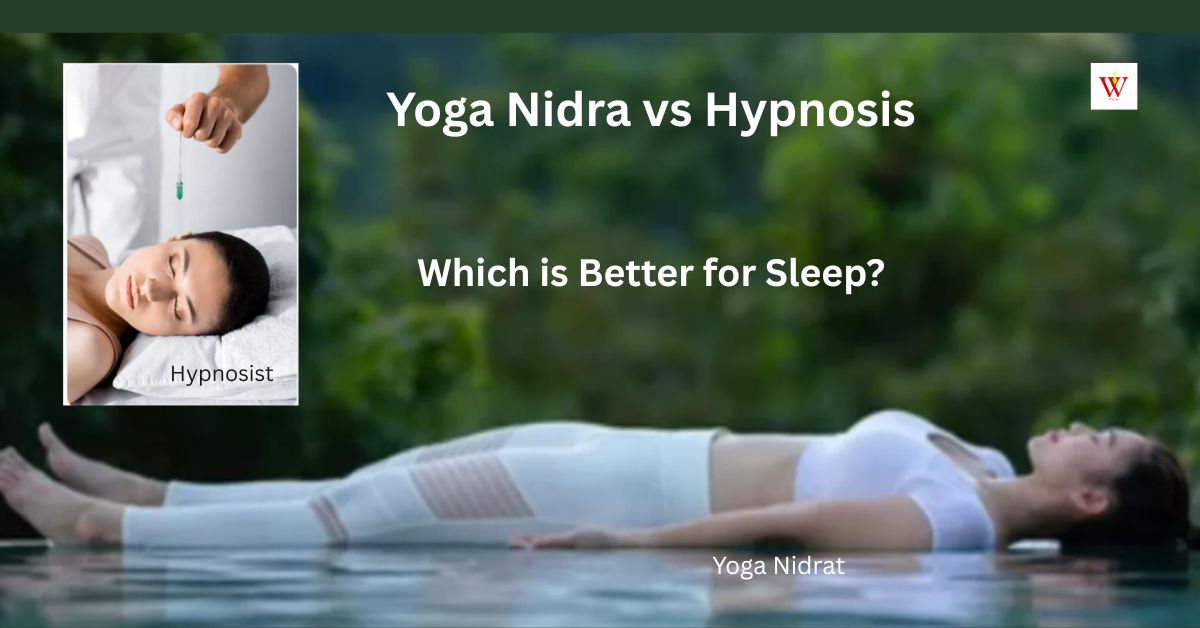In a world where the mind rarely rests and the soul seeks silence, two profound practices emerge – Yoga Nidra and Hypnosis. One is rooted in the timeless wisdom of the Vedas, guiding the practitioner into a sacred stillness beyond thought. The other, a tool of modern psychology, attempts to reprogram the restless mind through suggestion. While both offer deep relaxation, only one leads us inward – not merely to sleep, but to the soul’s true sanctuary.
Sleep – A Bridge Between Worlds
Sleep is not just the absence of activity; it is a sacred return to stillness. In ancient Indian tradition, deep rest was not only physical but also a pathway to higher awareness. Today, as sleeplessness and stress plague modern society, two powerful techniques – Yoga Nidra and Hypnosis – offer hope.
But which is better for sleep?
Let us explore this through Vedic wisdom, scientific inquiry, and soulful reflection.
What is Yoga Nidra ?
Yoga Nidra, or “Yogic Sleep,” is a guided meditative state between waking and sleeping. It is a practice that originated from the Tantras and Upanishads, allowing the practitioner to remain conscious in deep relaxation.
🔹 Scriptural Reference:
The Mandukya Upanishad describes four states of consciousness:
“Jagrat (waking), Swapna (dream), Sushupti (deep sleep), and Turiya (pure awareness).”
Yoga Nidra guides the practitioner toward Turiya, the awareness behind sleep.
🔹 Key Benefits:
- Induces deep rest without actual sleep
- Heals the nervous system
- Enhances memory, emotional resilience, and inner peace
- Awakens spiritual insight
What is Hypnosis ?
Hypnosis is a psychological technique where a person enters a highly suggestible and relaxed state. It is widely used in Western psychology for behavior modification, stress reduction, and sleep issues.
Scientific Viewpoint:
Hypnosis involves:
- A narrowed focus of attention
- Increased suggestibility
- Altered brainwave patterns (theta and alpha states)
It’s been clinically used for:
- Insomnia treatment
- Anxiety and PTSD
- Smoking cessation and habit control
Yoga Nidra vs Hypnosis: A Spiritual and Scientific Comparison
| Aspect | Yoga Nidra | Hypnosis |
|---|---|---|
| Origin | Ancient India (Tantras, Upanishads) | 18th-century Western psychology |
| Goal | Union with Self; healing through awareness | Behavior modification or therapeutic goals |
| State of Mind | Conscious awareness in deep rest (Turiya) | Semi-conscious suggestibility |
| Method | Sankalpa (intention), body scan, breath, inner visualization | Verbal suggestion, imagery, regression |
| Risk | Very safe, spiritually uplifting | May cause dependency or emotional triggering |
| Scientific Support | Reduces cortisol, improves sleep quality (IJSRM 2020) | Proven in clinical trials for insomnia (NIH, 2022) |
Why Ancient Sages Preferred Yogic Sleep Over Hypnosis
The Yoga Sutras of Patanjali teach:
“Yoga chitta vritti nirodhah” – Yoga is the stilling of the fluctuations of the mind. (Yoga Sutra 1.2)
Unlike hypnosis, which still relies on mental programming, Yoga Nidra transcends the mind itself.
It helps dissolve:
- Karma-samskaras (subtle impressions)
- Emotional trauma
- Sleep-related disorders, not by suppression, but by awareness and surrender
Scientific Research Backs Both – But Yoga Nidra Goes Deeper
🔹 Yoga Nidra and Sleep Quality
A 2020 study published in the International Journal of Scientific Research in Medicine found:
Participants practicing Yoga Nidra daily reported better sleep quality, emotional stability, and reduced anxiety scores compared to control groups.
🔹 Hypnosis and Insomnia
According to the National Institutes of Health (NIH):
Hypnotherapy shows moderate evidence in reducing sleep onset time and improving subjective sleep quality.
Conclusion: Hypnosis works on the surface mind; Yoga Nidra works beyond the mind.
Cultural Context: Why the World is Returning to Vedic Wisdom
In India, Yoga Nidra is not a therapy; it is a spiritual practice (sadhana). Gurus like Swami Satyananda Saraswati revived it for the modern world. Today, even Westerners seek out Yoga Nidra as part of mindfulness retreats and spiritual wellness tourism.
As per the Rigveda (10.190.1):
“Ritam cha satyam cha abhiddhat tapaso’dhyajayata”
(From Tapas (deep inner meditation) arise Truth and Order)
Yoga Nidra is Tapas – the heat of awareness that burns ignorance and restores natural sleep rhythms.
Which is Better for Sleep ?
If you want quick relief, hypnosis might work.
If you want deep healing, spiritual growth, and lasting rest – Yoga Nidra is the higher path.
Just as the lotus grows from the mud, Yoga Nidra helps the soul bloom through stillness.
Conclusion: Rest Not Just the Body, but the Soul
In a restless world, both Yoga Nidra and Hypnosis offer valuable tools. But one was born from the science of the soul (Adhyatma Vidya) – that is Yoga Nidra.
May your sleep not only refresh your body but bring you closer to your true Self.
“Om Shantih Shantih Shantih” – Peace within, Peace around, Peace Eternal.
Related FAQs (People also ask)
Q1. Is Yoga Nidra a form of hypnosis ?
Yoga Nidra and hypnosis both involve deep relaxation, but Yoga Nidra maintains conscious awareness and has a spiritual purpose, unlike hypnosis which focuses on suggestibility.
Q2. Can Yoga Nidra help with insomnia ?
Yes. Scientific studies and ancient wisdom confirm that Yoga Nidra reduces anxiety, balances brainwaves, and improves sleep quality.
Q3. Is hypnosis safe for everyone ?
Hypnosis is generally safe but may not suit people with trauma, PTSD, or trust issues, as it can bring suppressed memories to the surface.
Q4. Which is more natural: Yoga Nidra or Hypnosis ?
Yoga Nidra is rooted in natural yogic rhythms and has no external control, making it more organic and holistic.
Also Read :

2 thoughts on “Yoga Nidra vs Hypnosis: Which is Better for Sleep?”